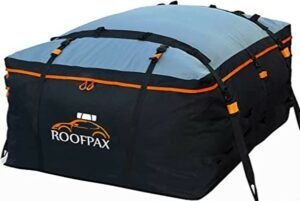Has it ever happened that you planned on a road trip with your entire family and the car trunk couldn’t fit your luggage? Well, it has happened to all of us, and the probability is still higher nowadays, especially with those smaller SUV and city cars. So, what’s the solution? Well, the answer is a car roof carrier! Car roof carriers are predominant these days especially while camping or even short road trips. They are a boon especially when you are traveling with your entire family.
So, today in this article, we will help you with “how to choose the best, car roof top carrier” according to your needs! Let’s get started.
What Exactly is a Car Roof Top Carrier?
A car roof top carrier is nothing but an additional storage compartment (just like your trunk). It becomes extremely useful in scenarios where there’s not much space in your trunk (as in the case of city cars or even sedans) or even when you are traveling with your entire family, friends, etc. Moreover, not only does it come in handy for extra storage, but it can also even prove beneficial to campers, hikers, or even sports players for storing their equipment.
Advantages of a Car Roof Top Carrier
There are numerous advantages of using a roof top carrier. I’ve included a few examples below.
- Increased Storage Capacity: Car roof top carriers provide additional space for storing luggage, camping gear, sports equipment, and other bulky items, freeing up valuable space inside the vehicle.
- Versatility: Roof top carriers come in various sizes and designs, allowing you to choose one that suits your specific needs. Whether you need extra space for a road trip, camping adventure, or transporting large items, there’s a carrier to match.
- Easy Installation: Most car roof top carriers are designed for easy installation and can be securely attached to the vehicle’s roof rack or crossbars without the need for any specialized tools or equipment.
- Protection from Elements: A roof top carrier offers protection from weather conditions such as rain, snow, or dust. It keeps your belongings dry and clean, ensuring they arrive at your destination in excellent condition.
- Improved Interior Comfort: By utilizing a roof top carrier, you can keep the vehicle’s interior clutter-free, allowing passengers to enjoy more legroom and a comfortable seating area.
- Enhanced Safety: When properly loaded and secured, roof top carriers have minimal impact on the vehicle’s handling and stability. They are designed to withstand wind resistance and provide a safe way to transport extra belongings.
- Fuel Efficiency: Compared to towing a trailer, using a roof top carrier generally has less impact on fuel efficiency. It minimizes the additional drag and weight that can come with towing, resulting in better mileage.
- Easy Storage: When not in use, many roof top carriers can be collapsed or folded, making them compact and easy to store in a garage or shed until the next adventure.
Remember to carefully follow the manufacturer’s instructions and load capacity guidelines when using a car roof top carrier to ensure safe and secure transportation.
The Different Types of Car Roof Top Carriers!

a.) Rigid: Roof boxes that are rigid in design are the most prevalent. Their plastic or composite material shells provide excellent weather protection, and the key locks make them safer against burglary. Their aerodynamic profiles help to reduce over consumption of gasoline, and some models have internal mounting points that can be used to connect ski racks or netting to keep the contents from moving around. It takes two persons to put them on a vehicle, though, because they are large and cumbersome.
b.) Flexible: Flexible roof boxes are becoming increasingly popular since they are more convenient to store. They are generally made of waterproof fabrics and may be folded and stored in a bag to save on storage space. Furthermore, when they are being loaded, their sizes are adjusted to accommodate the volume of their contents.
Because the flexible roof boxes may be folded down when they are not fully loaded, they reduce wind intake and hence reduce fuel usage. Because they are lighter than rigid roof boxes, a single person may quickly and easily install them.
c.) Soft: Soft roof boxes, on the other hand, are more prone to theft of luggage in the event of a heist. Their closing mechanisms are frequently comprised of a zipper that is secured with a padlock.
Some Points to Consider when Choosing a Roof Top Carrier
- Before purchasing a roof carrier, consider the type of vehicle on which it will be mounted (see the technical data in the vehicle’s handbook if necessary), both in terms of its size and installation, as well as the opening it will provide (side or rear opening).
- Make certain that the carrier you purchase complies with safety regulations.
- What you want to use it for should be considered: ski equipment, specialized products, camping equipment, or any other form of application. The response will allow you to choose between a short or long model, as well as between a soft or firm model.
- Do you wish to transport additional items that can be secured to the roof or trunk of your car (for example, windsurfers, bicycles, and so on)?
- What is the approximate weight of the items you intend to transport in your roof box? Consult the manufacturer’s instructions for the box you intend to purchase to determine the maximum weight that can be loaded.
How to Properly Load a Roof Top Carrier?

- Make certain that the carrier is adequately loaded to ensure everyone’s safety.
- The weight of the luggage must be spread evenly throughout the carrier.
- Luggage should not be able to move or shift around in the carrier, therefore it is best to lock it tightly or wedge it between other objects, such as clothes or towels.
- Light luggage should be placed in the roof box and heavier stuff should be placed in the car trunk to keep the center of gravity of your vehicle as low as feasible.
- You should try to keep the heaviest objects you intend to transport in the roof box as close to the brackets/bars as you can.
- Check that the carrier is properly latched and closed before leaving.
- Protect the interior of the carrier by packing goods that could cause damage. Pack objects that cannot get wet by using waterproof plastic bags.
Things to keep in Mind while Driving with a Roof Top Carrier!
- Remember that your car is +/- 60 cm higher than normal due to the roof (be cautious of low tunnels, underground parking spaces, toll booths, petrol stations, and other similar obstacles)! Tip: Place a prominent label near your dashboard to serve as a reminder that you are driving with a roof box attached.
- The aerodynamics of your car are altered because of the roof box. It will react differently to wind (your car can move sideways), braking (it can take longer to brake), turns, and so on. As a result, be cautious when driving and keep these considerations in mind when planning your journey (e.g., avoid small roads with curves as much as possible).
- It is recommended that you do not travel faster than 130 km/h.
- Check your roof box during breaks (rest periods) and, in general, every time you get into your vehicle.
- The addition of a roof box will increase your fuel use. If it is no longer required, it should be removed.
- Remember to consider other factors that contribute to your safety on the road, such as vehicle preparation, driving in the snow, (winter) tires, the usage of chains, mandatory equipment, and weather conditions, among others.
The Bottom Line
So, now that you know about roof top carriers, next time it won’t be a problem when you are traveling with your family, friends, etc. However, before purchasing any carrier, just make sure to skim through our guidelines once again! It will assuredly help you in making an even more clear decision.
Also, if you are an expert on this subject and feel that we might have missed on any crucial aspect, feel free to leave your thoughts in the comments below. If the info is valuable, we will surely add it to our article. Till then stay tuned! If you would like to know what I think are the best rated and safest roof carriers simply read my “6 Vehicle Roof Top Carriers you Can’t Go Without! ” … If you think I forgot something or if you simply want to share a story or some advice, feel free to leave a comment below. Stay Safe and Happy Camping.!

